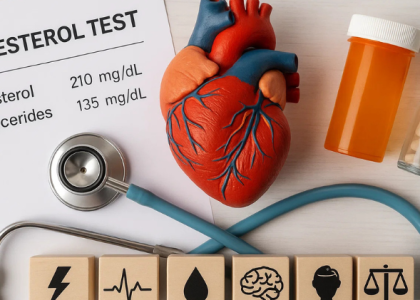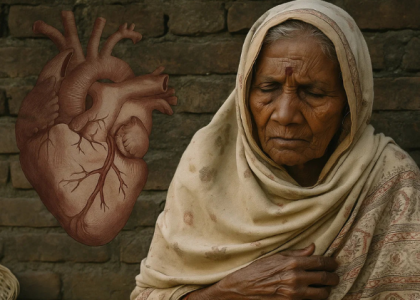Even non-smokers with healthy habits are at risk. Here’s the science and the steps to protect yourself.
You eat home-cooked meals, don’t smoke, and even walk every evening — but you may still be headed toward a heart attack. Why is this happening to so many Indian Americans? The answer lies in a complex mix of genetics, lifestyle, and cultural factors that many people don’t understand until it’s too late.
The Surprising Heart Risk We Face
Indians living in America have 2–3 times higher risk of heart disease compared to White Americans. This higher risk exists even when Indians don’t smoke, maintain normal weight, and have no family history of heart problems.
Take Suresh, a 52-year-old software engineer in California. He walked daily, had normal blood pressure, and followed a mostly vegetarian diet. Yet during a routine checkup, his doctor discovered significant blockages in his heart arteries requiring immediate treatment. His case isn’t unusual in our community.
Why Our Bodies React Differently
The Genetics of Insulin Resistance
Our bodies process carbohydrates differently than many other ethnic groups. Think of insulin as the key that helps sugar enter your cells for energy. For many Indians, this key doesn’t work as well—a condition called insulin resistance.
When this happens, the body needs to produce more insulin to do the same job. Higher insulin levels lead to more fat storage, especially around the organs in your belly.
TOFI: Thin Outside, Fat Inside
Many Indians have what doctors call “TOFI” syndrome—Thin Outside, Fat Inside. You might look slim in your arms and legs, but carry dangerous fat around your internal organs. This hidden fat isn’t harmless—it actively produces chemicals that damage your heart.
Dr. Namratha Kandula, a researcher who studies South Asian heart health, explains it like this: “Many of my Indian patients look thin or normal weight, but scans show they have the internal fat pattern of someone who appears much heavier.”
The Harmful Inside Fat
The fat that wraps around your organs (visceral fat) is different from the fat under your skin. This visceral fat:
- Creates inflammation throughout your body
- Makes your blood more likely to form clots
- Raises your blood sugar and blood pressure
- Directly damages your artery walls
The MASALA Study: Science Confirms Our Risk
Researchers at UCSF and Northwestern University conducted a special study called MASALA (Mediators of Atherosclerosis in South Asians Living in America) to understand why heart disease affects us differently.
The study found that Indians in America have:
- More plaque buildup in heart arteries at younger ages
- Higher insulin resistance even with normal blood sugar readings
- Different fat distribution patterns (more belly fat, less muscle)
- Traditional risk calculators that underestimate our actual risk
Dr. Alka Kanaya, who leads the MASALA study, notes that standard heart risk calculators can miss up to 25% of high-risk Indians because they were designed for other populations.
Ask Your Doctor About These Tests
- Coronary Calcium Score
- ApoB
- Lipoprotein(a)
- Fasting insulin
- Waist circumference measurement
When Cultural Patterns Meet American Lifestyle
Our cultural background creates unique challenges when combined with American life:
Food Traditions
Many Indian meals center around white rice or refined flour (maida) with limited protein. Add typical American portion sizes and food availability, and the risk increases.
Exercise Perspectives
In many Indian families, structured exercise wasn’t traditionally encouraged, especially for older adults or women. Comments like “Why are you running at your age?” might discourage family members from staying active.
Medical Attitudes
Some cultural patterns can delay care:
- Tendency to downplay symptoms (“It’s just gas”)
- Hesitation to discuss health concerns
- Reluctance to take medications
- Stigma around certain conditions
Practical Steps to Protect Your Heart
The good news? You can significantly reduce your risk with these targeted approaches:
Modify (Not Eliminate) Traditional Foods
Small changes to familiar foods can make a big difference:
- Mix white rice with brown rice or millets (50/50)
- Include protein at every meal (dal, yogurt, eggs, fish)
- Add extra vegetables to curries and rice dishes
- Reduce fried snacks to occasional treats rather than daily items
- Measure cooking oil with a spoon instead of pouring freely
Move Throughout the Day
Indians respond particularly well to:
- 10-minute walks after meals (especially dinner)
- Standing breaks during work
- Family activities that include movement
- Traditional practices like yoga
Success Stories Show Change Is Possible
Priya, a 58-year-old accountant in Texas, discovered she had high calcium scores despite normal cholesterol. Instead of drastic changes, she made targeted adjustments:
- Reduced rice portions by 25%
- Added protein to breakfast
- Took 15-minute walks after dinner with her husband
After 18 months, her follow-up tests showed significantly improved numbers and stopped the progression of artery plaque.
The Heart of the Matter
Our Indian heritage gives us many strengths—close family ties, rich traditions, and resilient spirits. We don’t need to abandon our cultural identity to protect our hearts. Instead, we need to understand our unique risks and make smart adaptations.
Remember: Even small changes can dramatically reduce your heart risk. By combining the best of our traditional wisdom with modern medical knowledge, we can enjoy longer, healthier lives while honoring our cultural roots.
Don’t wait for symptoms. The best time to protect your heart is before the damage begins. Share this article with someone you love — it could save their life.




